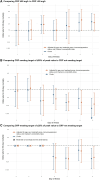Association of Daily Body Temperature, White Blood Cell Count, and C-reactive Protein With Mortality and Persistent Bacteremia in Patients With Staphylococcus Aureus Bacteremia: A Post Hoc Analysis of the CAMERA2 Randomized Clinical Trial
- PMID: 39963704
- PMCID: PMC11832037
- DOI: 10.1093/ofid/ofaf063
Association of Daily Body Temperature, White Blood Cell Count, and C-reactive Protein With Mortality and Persistent Bacteremia in Patients With Staphylococcus Aureus Bacteremia: A Post Hoc Analysis of the CAMERA2 Randomized Clinical Trial
Abstract
Introduction: Classification of patients with Staphylococcus aureus bacteremia as complicated versus uncomplicated is based on a combination of clinical and microbiologic variables. Whether daily body temperature and common laboratory tests such as C-reactive protein (CRP) and white blood cell (WBC) can improve risk stratification algorithms is unclear.
Methods: We conducted a post hoc secondary analysis of the CAMERA2 trial, which enrolled hospitalized adult patients with methicillin-resistant S aureus bacteremia and prospectively collected daily body temperature and peripheral blood WBC and CRP. We evaluated the prognostic relevance of each parameter by calculating crude and adjusted odds ratios for 90-day all-cause mortality comparing patients with the abnormal parameter of interest versus those with normal parameters on each day of illness.
Results: A total of 345 patients were included in this analysis, of whom 63 (18.3%) died within 90 days. Fever (body temperature ≥38.0 °C) was associated with increased odds of 90-day mortality from day 4 and onwards. Fever later in the illness course was associated with higher adjusted odds of mortality (8.78; 95% confidence interval, 2.78-27.7 on day 7 vs adjusted odds ratio 3.70; 95% CI, 1.58-8.67 on day 4). In contrast, CRP and abnormal WBC count did not demonstrate a consistent or temporal association with mortality.
Conclusions: Persistent fever after 72 hours is associated with increased mortality in patients with methicillin-resistant S aureus bacteremia, supporting recommendations that this should be kept as a criterion for classifying patients as either "high-risk" or "complicated." Within this dataset, there was limited additional predictive value in WBC or CRP.
Keywords: MRSA; c-reactive protein; risk stratification; staphylococcus aureus bacteremia; white blood cell.
© The Author(s) 2025. Published by Oxford University Press on behalf of Infectious Diseases Society of America.
Conflict of interest statement
Potential Conflicts of interest: None declared.
Figures




References
-
- Ingram PR, Cheng AC, Murray RJ, et al. . What do infectious diseases physicians do? A 2-week snapshot of inpatient consultative activities across Australia, New Zealand and Singapore. Clin Microbiol Infect 2014; 20(10): O737–44. - PubMed
-
- Bai AD, Lo CKL, Komorowski AS, et al. . Staphylococcus aureus bacteraemia mortality: a systematic review and meta—analysis. Clin Microbiol Infect 2022; 28(8): 1076–84. - PubMed
-
- Liu C, Bayer A, Cosgrove SE, et al. . Clinical practice guidelines by the Infectious Diseases Society of America for the treatment of methicillin—resistant Staphylococcus aureus infections in adults and children. Clin Infect Dis 2011; 52(3): e18–55. - PubMed
-
- Fowler VG Jr., Olsen MK, Corey GR, et al. . Clinical identifiers of complicated Staphylococcus aureus bacteremia. Arch Intern Med 2003; 163(17): 2066–72. - PubMed
LinkOut - more resources
Full Text Sources
Research Materials
Miscellaneous

